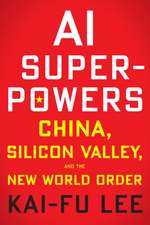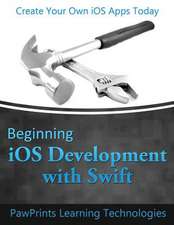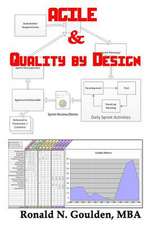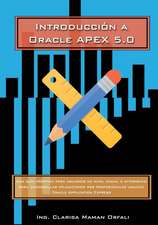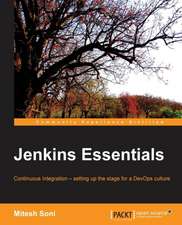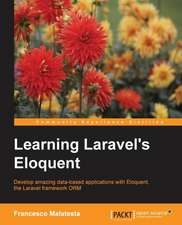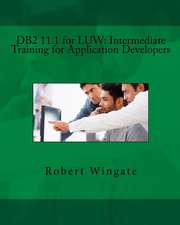Deep Learning Illustrated: Addison-Wesley Data & Analytics Series
Autor Aglae Bassens, Grant Beyleveld, Jon Krohnen Limba Engleză Paperback – 17 dec 2019
Preț: 281.04 lei
Preț vechi: 351.31 lei
-20% Nou
Puncte Express: 422
Preț estimativ în valută:
53.77€ • 56.15$ • 44.41£
53.77€ • 56.15$ • 44.41£
Carte disponibilă
Livrare economică 25 martie-08 aprilie
Livrare express 08-14 martie pentru 42.79 lei
Preluare comenzi: 021 569.72.76
Specificații
ISBN-13: 9780135116692
ISBN-10: 0135116694
Pagini: 416
Dimensiuni: 179 x 231 x 22 mm
Greutate: 0.77 kg
Editura: Pearson Education (US)
Seria Addison-Wesley Data & Analytics Series
ISBN-10: 0135116694
Pagini: 416
Dimensiuni: 179 x 231 x 22 mm
Greutate: 0.77 kg
Editura: Pearson Education (US)
Seria Addison-Wesley Data & Analytics Series
Cuprins
Figures xix
Tables xxvii
Examples xxix
Foreword xxxiii
Preface xxxv
Acknowledgments xxxix
About the Authors xli
Part I: Introducing Deep Learning 1
Chapter 1: Biological and Machine Vision 3
Biological Vision 3
Machine Vision 8
TensorFlow Playground 17
Quick, Draw! 19
Summary 19
Chapter 2: Human and Machine Language 21
Deep Learning for Natural Language
Processing 21
Computational Representations of Language 25
Elements of Natural Human Language 33
Google Duplex 35
Summary 37
Chapter 3: Machine Art 39
A Boozy All-Nighter 39
Arithmetic on Fake Human Faces 41
Style Transfer: Converting Photos into Monet (and Vice Versa) 44
Make Your Own Sketches Photorealistic 45
Creating Photorealistic Images from Text 45
Image Processing Using Deep Learning 46
Summary 48
Chapter 4: Game-Playing Machines 49
Deep Learning, AI, and Other Beasts 49
Three Categories of Machine Learning Problems 53
Deep Reinforcement Learning 56
Video Games 57
Board Games 59
Manipulation of Objects 67
Popular Deep Reinforcement Learning Environments 68
Three Categories of AI 71
Summary 72
Part II: Essential Theory Illustrated 73
Chapter 5: The (Code) Cart Ahead of the (Theory)
Horse 75
Prerequisites 75
Installation 76
A Shallow Network in Keras 76
Summary 84
Chapter 6: Artificial Neurons Detecting Hot Dogs 85
Biological Neuroanatomy 101 85
The Perceptron 86
Modern Neurons and Activation Functions 91
Choosing a Neuron 96
Summary 96
Key Concepts 97
Chapter 7: Artificial Neural Networks 99
The Input Layer 99
Dense Layers 99
A Hot Dog-Detecting Dense Network 101
The Softmax Layer of a Fast Food-Classifying Network 106
Revisiting Our Shallow Network 108
Summary 110
Key Concepts 110
Chapter 8: Training Deep Networks 111
Cost Functions 111
Optimization: Learning to Minimize Cost 115
Backpropagation 124
Tuning Hidden-Layer Count and Neuron
Count 125
An Intermediate Net in Keras 127
Summary 129
Key Concepts 130
Chapter 9: Improving Deep Networks 131
Weight Initialization 131
Unstable Gradients 137
Model Generalization (Avoiding Overfitting) 140
Fancy Optimizers 145
A Deep Neural Network in
Keras 147
Regression 149
TensorBoard 152
Summary 154
Key Concepts 155
Part III: Interactive Applications of Deep Learning 157
Chapter 10: Machine Vision 159
Convolutional Neural Networks 159
Pooling Layers 169
LeNet-5 in Keras 171
AlexNet and VGGNet in Keras 176
Residual Networks 179
Applications of Machine Vision 182
Summary 193
Key Concepts 193
Chapter 11: Natural Language Processing 195
Preprocessing Natural Language Data 195
Creating Word Embeddings with word2vec 206
The Area under the ROC Curve 217
Natural Language Classification with Familiar Networks 222
Networks Designed for Sequential Data 240
Non-sequential Architectures: The Keras Functional API 251
Summary 256
Key Concepts 257
Chapter 12: Generative Adversarial Networks 259
Essential GAN Theory 259
The Quick, Draw! Dataset 263
The Discriminator Network 266
The Generator Network 269
The Adversarial Network 272
GAN Training 275
Summary 281
Key Concepts 282
Chapter 13: Deep Reinforcement Learning 283
Essential Theory of Reinforcement Learning 283
Essential Theory of Deep Q-Learning Networks 290
Defining a DQN Agent 293
Interacting with an OpenAI Gym Environment 300
Hyperparameter Optimization with SLM Lab 303
Agents Beyond DQN 306
Summary 308
Key Concepts 309
Part IV: You and AI 311
Chapter 14: Moving Forward with Your Own Deep Learning Projects 313
Ideas for Deep Learning Projects 313
Resources for Further Projects 317
The Modeling Process, Including Hyperparameter Tuning 318
Deep Learning Libraries 321
Software 2.0 324
Approaching Artificial General Intelligence 326
Summary 328
Part V: Appendices 331
Appendix A: Formal Neural Network Notation 333
Appendix B: Backpropagation 335
Appendix C: PyTorch 339
PyTorch Features 339
PyTorch in Practice 341
Index 345
Tables xxvii
Examples xxix
Foreword xxxiii
Preface xxxv
Acknowledgments xxxix
About the Authors xli
Part I: Introducing Deep Learning 1
Chapter 1: Biological and Machine Vision 3
Biological Vision 3
Machine Vision 8
TensorFlow Playground 17
Quick, Draw! 19
Summary 19
Chapter 2: Human and Machine Language 21
Deep Learning for Natural Language
Processing 21
Computational Representations of Language 25
Elements of Natural Human Language 33
Google Duplex 35
Summary 37
Chapter 3: Machine Art 39
A Boozy All-Nighter 39
Arithmetic on Fake Human Faces 41
Style Transfer: Converting Photos into Monet (and Vice Versa) 44
Make Your Own Sketches Photorealistic 45
Creating Photorealistic Images from Text 45
Image Processing Using Deep Learning 46
Summary 48
Chapter 4: Game-Playing Machines 49
Deep Learning, AI, and Other Beasts 49
Three Categories of Machine Learning Problems 53
Deep Reinforcement Learning 56
Video Games 57
Board Games 59
Manipulation of Objects 67
Popular Deep Reinforcement Learning Environments 68
Three Categories of AI 71
Summary 72
Part II: Essential Theory Illustrated 73
Chapter 5: The (Code) Cart Ahead of the (Theory)
Horse 75
Prerequisites 75
Installation 76
A Shallow Network in Keras 76
Summary 84
Chapter 6: Artificial Neurons Detecting Hot Dogs 85
Biological Neuroanatomy 101 85
The Perceptron 86
Modern Neurons and Activation Functions 91
Choosing a Neuron 96
Summary 96
Key Concepts 97
Chapter 7: Artificial Neural Networks 99
The Input Layer 99
Dense Layers 99
A Hot Dog-Detecting Dense Network 101
The Softmax Layer of a Fast Food-Classifying Network 106
Revisiting Our Shallow Network 108
Summary 110
Key Concepts 110
Chapter 8: Training Deep Networks 111
Cost Functions 111
Optimization: Learning to Minimize Cost 115
Backpropagation 124
Tuning Hidden-Layer Count and Neuron
Count 125
An Intermediate Net in Keras 127
Summary 129
Key Concepts 130
Chapter 9: Improving Deep Networks 131
Weight Initialization 131
Unstable Gradients 137
Model Generalization (Avoiding Overfitting) 140
Fancy Optimizers 145
A Deep Neural Network in
Keras 147
Regression 149
TensorBoard 152
Summary 154
Key Concepts 155
Part III: Interactive Applications of Deep Learning 157
Chapter 10: Machine Vision 159
Convolutional Neural Networks 159
Pooling Layers 169
LeNet-5 in Keras 171
AlexNet and VGGNet in Keras 176
Residual Networks 179
Applications of Machine Vision 182
Summary 193
Key Concepts 193
Chapter 11: Natural Language Processing 195
Preprocessing Natural Language Data 195
Creating Word Embeddings with word2vec 206
The Area under the ROC Curve 217
Natural Language Classification with Familiar Networks 222
Networks Designed for Sequential Data 240
Non-sequential Architectures: The Keras Functional API 251
Summary 256
Key Concepts 257
Chapter 12: Generative Adversarial Networks 259
Essential GAN Theory 259
The Quick, Draw! Dataset 263
The Discriminator Network 266
The Generator Network 269
The Adversarial Network 272
GAN Training 275
Summary 281
Key Concepts 282
Chapter 13: Deep Reinforcement Learning 283
Essential Theory of Reinforcement Learning 283
Essential Theory of Deep Q-Learning Networks 290
Defining a DQN Agent 293
Interacting with an OpenAI Gym Environment 300
Hyperparameter Optimization with SLM Lab 303
Agents Beyond DQN 306
Summary 308
Key Concepts 309
Part IV: You and AI 311
Chapter 14: Moving Forward with Your Own Deep Learning Projects 313
Ideas for Deep Learning Projects 313
Resources for Further Projects 317
The Modeling Process, Including Hyperparameter Tuning 318
Deep Learning Libraries 321
Software 2.0 324
Approaching Artificial General Intelligence 326
Summary 328
Part V: Appendices 331
Appendix A: Formal Neural Network Notation 333
Appendix B: Backpropagation 335
Appendix C: PyTorch 339
PyTorch Features 339
PyTorch in Practice 341
Index 345
Notă biografică
Jon Krohn is the chief data scientist at untapt, a machine learning startup in New York. He leads a flourishing Deep Learning Study Group, presents the acclaimed Deep Learning with TensorFlow LiveLessons in Safari, and teaches his Deep Learning curriculum at the NYC Data Science Academy. Jon holds a doctorate in neuroscience from Oxford University and has been publishing on machine learning in leading academic journals since 2010. Grant Beyleveld is a doctoral candidate at the Icahn School of Medicine at New York's Mount Sinai hospital, researching the relationship between viruses and their hosts. A founding member of the Deep Learning Study Group, he holds a masters in molecular medicine and medical biochemistry from the University of Witwatersrand. Aglaé Bassens is a Belgian artist based in Brooklyn. She studied fine arts at The Ruskin School of Drawing and Fine Art, Oxford University, and University College London's Slade School of Fine Arts. Along with her work as an illustrator, her practice includes still life painting and murals.









